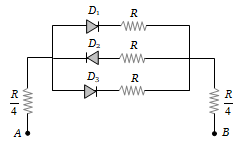In the circuit, if the forward voltage drop for the diode is 0.5V, the current will be

(a) 3.4 mA
(b) 2 mA
(c) 2.5 mA
(d) 3 mA

(b) 2 mA
(c) 2.5 mA
(d) 3 mA
Current in the circuit will be
(a)
(b)
(c)
(d)
1. \(1.5~\Omega\)
2. \(5~\Omega\)
3. \(6.67~\Omega\)
4. \(200~\Omega\)
In the following common emitter configuration an NPN transistor with current gain = 100 is used. The output voltage of the amplifier will be
(1) 10 mV
(2) 0.1 V
(3) 1.0 V
(4) 10 V
A sinusoidal voltage of peak value 200 volts is connected to a diode and resistor R in the circuit shown so that half-wave rectification occurs. If the forward resistance of the diode is negligible compared to R the r.m.s voltage (in volt) across R is approximately
(1) 200
(2) 100
(3)
(4) 280
The junction diode in the following circuit requires a minimum current of 1 mA to be above the knee point (0.7 V) of its I-V characteristic curve. The voltage across the diode is independent of current above the knee point. If = 5 V, then the maximum value of R so that the voltage is above the knee point, will be
(1) 4.3 k
(2) 860 k
(3) 4.3
(4) 860
In the circuit given below, V(t) is the sinusoidal voltage source, voltage drop (t) across the resistance R is
(1) Is half wave rectified
(2) Is full wave rectified
(3) Has the same peak value in the positive and negative half cycles
(4) Has different peak values during positive and negative half cycle
The peak voltage in the output of a half-wave diode rectifier fed with a sinusoidal signal without filter is 10 V. The dc component of the output voltage is
(1) V
(2) V
(3) 10 V
(4) V
A transistor is used as an amplifier in CB mode with a load resistance of 5 k. The current gain of the amplifier is 0.98 and the input resistance is 70 , the voltage gain and power gain respectively are :
(1) 70, 68.6
(2) 80, 75.6
(3) 60, 66.6
(4) 90, 96.6
In the following circuits PN-junction diodes , and are ideal for the following potential of A and B, the correct increasing order of resistance between A and B will be
(i) – 10 V, – 5V (ii) – 5V, – 10 V
(iii) – 4V, – 12V
(a) (i) < (ii) < (iii) (b) (iii) < (ii) < (i)
(c) (ii) = (iii) < (i) (d) (i) = (iii) < (ii)













